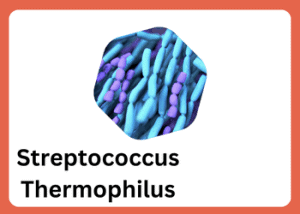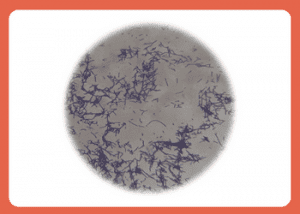Dive into the captivating world of S. thermophilus and discover its historical origin, role in food production, health benefits, and potential side effects.
Whether you savor yogurt or simply want to get familiar with bacteria inhabiting our digestive systems; this article will provide a plethora of fascinating facts about this remarkable microbe.
Table of Contents
What is It? How was Streptococcus Thermophilus Discovered?
S. thermophilus is a Gram-positive, spherical bacterium in the Streptococcaceae family that does not move about on its own. This bacteria can be found commonly within fermented foods such as cheese and yogurt, making it an important part of many people’s diets.
In the late 1800s, scientists were actively seeking to comprehend milk fermentation’s microbiology. Henri Duclaux, a French microbiologist, uncovered S. thermophilus in 1884; this microorganism is accountable for converting milk into yogurt and was fittingly christened “heat-loving streptococcus.” This name speaks to its capability of thriving even under intense temperatures.
 With his groundbreaking discovery, Duclaux opened the door to a richer understanding of milk fermentation and laid the foundation for further exploration into microorganisms’ role in food production and preservation.
With his groundbreaking discovery, Duclaux opened the door to a richer understanding of milk fermentation and laid the foundation for further exploration into microorganisms’ role in food production and preservation.
His findings marked a major milestone in microbiology that ushered in revolutionary advances within this field.
In recent years, researchers have been delving into the compelling mysteries surrounding S. thermophilus, uncovering intriguing facts about its biology and genetics.
Astonishingly, this bacteria generates lactic acid which confers a tart flavor to milk and various other dairy products while preserving them from potentially damaging microorganisms. Essentially then, it serves as both an appetizing ingredient and preservative!
In addition, S. thermophilus is a well-known probiotic, which implies that consuming it in adequate amounts can bring about health advantages. A multitude of studies has displayed that this bacteria strain has the potential to strengthen your immune system, advance digestion and combat various types of infections.
In sum, Streptococcus thermophilus is an intriguing microbe that has been essential to the dairy industry and our knowledge of microbiology. Henri Duclaux’s discovery in 1884 made a seismic impact on milk fermentation studies, opening up further avenues of investigation into microorganisms for scientists.
What Foods Contain Streptococcus Thermophilus?
S. thermophilus is a widely present organism in numerous fermented delicacies, with dairy-based products as its primary  habitat. Here are some examples:
habitat. Here are some examples:
- Yogurt: S. thermophilus and Lactobacillus bulgaricus are the two primary microorganisms used to ferment milk into yogurt – an ancient, yet still delectable dairy product.
- Cheese: By leveraging S. thermophilus, producers can craft superior hard and semi-hard cheeses like cheddar, mozzarella, and Parmesan.
- Buttermilk: Utilized in the creation of classic buttermilk, S. thermophilus produces a tart and fermented dairy beverage that is beloved around the world.
- Kefir: S. The thermophilus bacteria is frequently employed to formulate kefir, a traditional fermented milk drink that has been enjoyed in the Caucasus region for centuries.
- Sour cream: To bolster its tart flavor and extend its shelf life, S. thermophilus is often blended into sour cream.
It’s worth noting that S. thermophilus is not restricted to dairy products, but can also be found in smaller concentrations within some fermented vegetables (like sauerkraut) and meats (such as salami). Nevertheless, its presence in these foods usually pales in comparison to the concentration seen in dairy items.
Benefits & Side Effects. Is Streptococcus Thermophilus Harmful?
S. thermophilus is a variety of bacteria regularly found in fermented foods, and its consumption may be advantageous yet carries potential risks as well. Here are some perks and drawbacks associated with the intake of this microorganism:
Benefits:
- Probiotic properties: Consuming adequate amounts of S. thermophilus has been linked to numerous health benefits, such as improved digestion, enhanced immunity, and protection against various infections. Widely regarded as a probiotic food source, this microorganism can work wonders for the human body when ingested regularly.
- Lactose digestion: S. thermophilus produces the essential lactase, an enzyme that helps in breaking down milk sugar (lactose), making it a beneficial component of dairy products for those with lactose intolerance.
- Nutrient production: The fermentation process of S. thermophilus yields a selection of vitamins and vital nutrients such as folate, riboflavin, and B12 – all of which can positively improve your health or wellness.
Side effects:
- Allergic reactions: Some people may be hypersensitive to S. thermophilus or other ingredients in fermented food items, which could cause itching, swelling, and difficulty breathing as symptoms of an allergic reaction.
- Adverse reactions in immunocompromised individuals: Despite being usually safe for the majority of people, S. thermophilus may cause detrimental reactions in individuals with an impaired immune system. This can include both infections and other medical issues that must be addressed immediately.
- Excessive consumption: Over-indulging in S. thermophilus or other probiotics can result in some uncomfortable digestive issues, including bloating, gas, and diarrhea.
S. thermophilus has been deemed safe for consumption and will not likely cause any adverse health effects in healthy individuals when taken as directed.
Even though fermented foods, such as S. thermophilus, are generally safe to consume, people with weakened immune systems or allergies should take extra precautions before consuming them due to the possibility of an adverse reaction.
Is Streptococcus thermophilus Good or Bad?
S. thermophilus is widely found in fermented food items like cheese and yogurt, where it displays its probiotic superpower – aiding digestion and supporting the immune system as well as one’s overall health.
While it is generally safe and provides numerous benefits to those who consume it, people with weakened immune systems or allergies may have adverse reactions when consuming foods that contain this probiotic strain.
Nevertheless, the positive effects of incorporating fermented products containing S. thermophilus into one’s diet far outweigh any potential risks for most individuals.
Streptococcus Thermophilus and Lactobacillus Bulgaricus
Both are two essential bacteria used in the manufacture of yogurt, cheeses, kefir, and other fermented dairy products.
Here are some key similarities and differences between these two bacteria:
| Streptococcus thermophilus | Lactobacillus bulgaricus |
|---|---|
| Gram-positive bacteria | Gram-positive bacteria |
| Non-motile | Non-motile |
| Ferments lactose to produce lactic acid | Ferments lactose to produce lactic acid |
| Requires heat to grow and reproduce | Grows best at slightly lower temperatures than S. thermophilus |
| Helps to create the thick and creamy texture of yogurt | Helps to create the tangy flavor of yogurt |
| May help to improve digestion and boost the immune system | May help to improve digestion and support gut health |
The combination of S. thermophilus and L. bulgaricus is crucial for creating the unique flavor and texture of yogurt, as well as other fermented dairy products.
While S. thermophilus largely contributes to its thick, creamy consistency, the role of L. bulgaricus lies in giving it a tangy taste that we all know so well.
Nevertheless, both bacteria are essential for breaking down lactose and generating lactic acid. This is the element that gives yogurt its distinctive sour flavor.
Furthermore, both S. thermophilus and L. bulgaricus were found to possess probiotic properties which could potentially provide beneficial effects such as better digestion and immunity boost when consumed in adequate amounts.
Frequently Asked Questions
What Are the Uses of Streptococcus Thermophilus?
Commonly found in raw milk, it is widely used as a starter culture for yogurt and cheese. Unfortunately, it can often form biofilms – an undesired outcome – which many dairy plants have experience with.
What is Streptococcus Thermophilus Also Known As?
This microorganism, known as a lactic acid microorganism, has the capacity to break down carbohydrates in dairy products and generate an excess of lactic acid.
Where is Streptococcus Thermophilus Found Naturally?
It is a natural inhabitant of raw milk in many parts of the world.
Conclusion
For many, S. thermophilus can be a safe and advantageous addition to their eating routine. In any case, certain people may encounter symptoms or hypersensitive responses from it.
 As researchers delve ever deeper into the intricate universe of gut microorganisms and how they are associated with our well-being, this strain is set to remain an area of interest for years to come.
As researchers delve ever deeper into the intricate universe of gut microorganisms and how they are associated with our well-being, this strain is set to remain an area of interest for years to come.
One of the most consequential attributes is its capacity to digest less common compounds.
While other bacteria like Bifidobacterium ssp. typically break down carbohydrates and fibers, Lactobacillus ssp specializes in lactose and sugar digestion – it stands out from these by tackling a wider range of substances, making it an essential part of any microbiome.
But, it is a real expert in protein and lipid digestion- how cool is that? It can break down casein, one of the most important proteins into peptides that can be used by your body. This assistance provided by Streptococcus thermophilus is like having an amazing mother-in-law who turns all negative stereotypes upside down.
